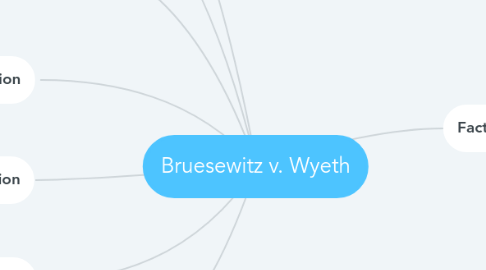
1. Issue
1.1. Can a Federal law shield manufacturers (Wyeth) from certain product liability lawsuits in state court that seek damages for health issues resulting from their vaccines?
2. Rule of Law
2.1. Intent of NCVIA (1986) was to make a faster, easier system than civil tort for seeking compensation.
2.1.1. Under NCVIA a person injured by a vaccine can file a petition for compensation in the US Court of Federal Claims and a special master makes an informal adjudication within 240 days. The US Court of Federal Claims reviews objections to the special master and enters final judgment.
2.1.1.1. A claimant may then accept this ruling or seek tort relief from the manufacturer. Manufacturers are in turn immunized from liability so long as they comply with regulatory requirements.
2.2. Shalala v. Whitecotton was used as precedent here.
3. Application
3.1. The special master denied the Buersewitzes claim on various grounds and they elected to reject the ruling and filed in State court.
3.1.1. The “even though” clause clarifies that since the vaccine was properly prepared and accompanied by warnings and directions, there is no liability. The design itself is not open to question under this interpretation.
3.1.1.1. Significant discussion was around the “if” clause and its intent. The dissent argues that “if” applies to any feasible design, while Scalia and the opinion of the Supreme Court believe it applies to the particular design at issue.
3.1.1.2. Significant discussion also around whether the intent of the legislation was to invoke comment k when using the word unavoidable (vs. unavoidably in §300aa-22(b)(1). Court rules that they did not intend to invoke this.
3.1.1.2.1. The rule is applied; Wyeth is shielded from liability in this case.
4. Conclusion
4.1. The rule of law: “No vaccine manufacturer shall be liable in a civil action for damages arising from a vaccine-related injury or death associated with the administration of a vaccine after October 1, 1988, if the injury or death resulted from side effects that were unavoidable even though the vaccine was properly prepared and was accompanied by proper directions and warnings” is applied.
4.1.1. The reason the rule applies is that the way “if” and “even though” are interpreted, the vaccine manufacturer shall not be liable.
5. Impact
5.1. In Milik v. Secretary of Health and Human Services the case was based on a similar premise. They argued that the Vaccine Act was unconstitutional and that even if constitutional, the special master’s decision was arbitrary and capricious.
5.1.1. The Miliks believe that under the original Act there is opportunity to reject the judgment in Vaccine court or elect to proceed in state or federal court, and this is now gone (in conjunction with Stern) which is unconstitutional.
5.1.1.1. In Payne v. TRI-STATE CAREFLIGHT, the case was actually about labor laws. The dispute (well, the short of it) was not related directly to vaccines.
5.1.1.2. Rather, the dispute was whether state or federal law should apply. The subtlety was obstacle preemption. The Supreme Court had ruled that obstacle preemption is appropriate where state law “stands as an obstacle” to the objectives and purposes of Congress.
5.1.1.2.1. The basis of the citation was establishing precedent for preemption and presumption of preemption. In other words, if state and federal laws conflict with one another, how shall the courts proceed? The Wyeth case was used in this manner, among many other cases.
5.1.1.3. Fishback v. HSBC RETAIL SERVICES, another case brought forth with regards to implied preemption (and unrelated to vaccines) also cited this express preemption decision in their case. This case was regarding credit liability on a charge account at a retailer.
6. Importance
6.1. This is important particularly to a pharma/vaccine company. It is important because it provides a shield, other than claims for injuries listed in the Table that are filed in a timely manner and are approved by the special master, against liability.
6.1.1. The intent is to incentivize vaccine manufacturers not to withdraw from the market. It effectively does this by limiting liability because there is a “greater good” for vaccines in many cases.
6.1.1.1. A vaccine manufacturer can then rest soundly knowing that so long as they comply with regulatory requirements they are limited in liability against tort action.
7. Influence
7.1. One business practice that has been influenced by this case is the excess of warning labels and directions by drug manufacturers/vaccine manufacturers. Some of the more ridiculous ones (see: Ibuprofen, Advair…both of which I take and have observed) are a clear attempt to adhere to the “proper warnings” portion of the law.
7.1.1. Another is perhaps medical marijuana. There appears to be at least some ambiguity around whether Federal law preempts more lax State laws with regards to medical marijuana. It is likely that if a case were to make it to the Supreme Court, they would argue that the Federal law preempts State law because State law is an obstacle.
8. Facts
8.1. Parties
8.1.1. Wyeth - vaccine manufacturer
8.1.2. Bruesewitz family - Hannah (daughter) received vaccine and suffered from hundreds of subsequent seizures
8.2. What Happened?
8.2.1. Hannah Bruesewitz received vaccines manufactured by Wyeth. Developed seizures requiring significant care.
8.2.2. Hannah’s parents filed a petition seeking compensation for her injuries. One month prior, new regulations removed seizures from the list of compensable injuries; petition denied.
8.2.3. In 1998 Wyeth pulled the vaccine from the market.
8.3. Procedural History
8.3.1. Bruesewitz family filed a petition; petition denied.
8.3.1.1. The Bruesewitzes filed suit in Pennsylvania state court on the basis of “failure to develop a safer vaccine” indicating Wyeth should be accountable for preventable injuries caused by vaccine’s defective design.
8.3.1.1.1. Federal judge dismissed the suit ruling that the National Childhood Vaccine Injury Act protected Wyeth. U.S. Court of Appeals for the 3rd circuit affirmed this ruling.
8.3.1.1.2. Supreme Court ruled in favor (6-2) of Wyeth.
